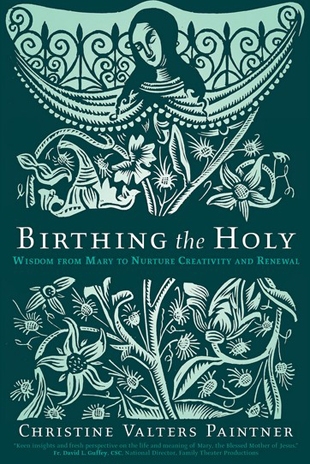Christine Valters Paintner is one of our favorite contemporary spiritual writers. She’s a part of our Living Spiritual Teacher’s Project, and we recently named her book, Breath Prayer, one of “The Best Spiritual Books of 2021.”
Birthing the Holy should appeal to anyone who has learned from Paintner in the past and will likely expand her community of readers to include those increasingly drawn to seeing and experiencing the holy through images and spiritual practices with the Divine Feminine.
The book’s content focuses on the Virgin Mary of Christian tradition but with an expansiveness that communicates to those outside Christianity. Even the language of virginity is stretched to be relevant far beyond the confines of traditional sexuality. For instance, Paintner writes, “Jungian analyst Marion Woodman describes the Virgin archetype as having less to do with physical intactness and purity as it does with emotional wholeness and sovereign power.”
The virginity of Mary is also compared to being “impregnated with divine love” and “being open and available to the divine mystery.”
Thus, March 25 — a day known to traditional Christians as the Feast of the Annunciation (when the archangel Gabriel told young Mary that she would be mother to the Son of God) — is here renamed as "Virgin: She Who Is Whole Unto Herself.” The lesson is made universal: “When we are virgins in the fullest sense, we do not require others to approve of what we do or how we act. We are in alignment with our deepest, truest nature.”
Elsewhere, “Queen of the Holy Rosary” stands alongside “Mary the Air We Breathe” and “She Who Brings Forth God’s Greening Power.” And beyond metaphors, each short chapter concludes with a blessing that’s an original prayer-poem by Paintner. One begins this way:
“Mary, we come to you knotted
in a hundred different ways.
Our hearts are knotted with grief and anger,
our bodies feel knotted with tension,
our minds knotted with anxiety and fear.
… Bless us with patience and wisdom;
support us in loosening our steady grip
so we might also prevent more knots
forming in days to come.”
There are other ways in which this book moves beyond Christianity. In Part II we find “Mustafia: She Who Is Chosen,” extolling the names and qualities of Mary in the Qur’an, quoting from the Islamic holy text as well as Sufi masters. “In a world filled with religious divisions, Mary can become a bridge between traditions, Islam and Christianity in particular. We can call upon Mary to help us reconcile tensions with those we 'other' and reject based on culture, skin color, and belief,” Paintner offers.
Mary is also a portal to God; she’s one who stands on holy ground; she’s the alchemical container; she shows us how to grieve; and she “infuses our every breath.” This is not your ordinary Virgin Mary, although every chapter is informed by religious sources. This is also the Divine Feminine, and She is available to anyone with eyes, ears, and breath.
Paintner encourages: “In our journeys of discernment it can be helpful to ask if we are breathing as fully into our lives as possible, or if we are breathing and living in a shallow way…. Ask Mary to reveal the places in your life where you could breathe more fully.”
